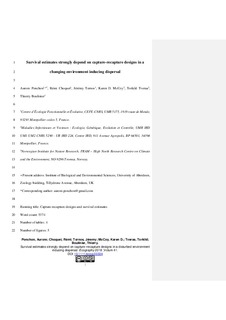Survival estimates strongly depend on capture–recapture designs in a disturbed environment inducing dispersal
Ponchon, Aurore; Choquet, Rémi; Tornos, Jéremy; McCoy, Karen D.; Tveraa, Torkild; Boulinier, Thierry
Journal article, Peer reviewed
Accepted version

Åpne
Permanent lenke
http://hdl.handle.net/11250/2494671Utgivelsesdato
2018Metadata
Vis full innførselSamlinger
- Publikasjoner fra CRIStin - NINA [2364]
- Scientific publications [1392]
Originalversjon
10.1111/ecog.03334Sammendrag
Capture-Recapture (CR) approaches are extensively used to estimate demographic parameters. Their robustness relies on the selection of suitable statistical models, but also on the sampling design and effort deployed in the field. In colonial or territorial species faithful to their breeding site, some recurrent local perturbations such as predation-induced breeding failure may lead individuals to disperse locally, potentially outside the study area. This might induce heterogeneity in CR histories and biases in demographic parameter estimates. Here, we assessed the effects of buffers areas and multi-site designs on dataset homogeneity and survival estimate accuracy. First, from a local multi-site long-term monitoring survey carried out in a colony of black-legged kittiwakes, we tested the homogeneity of individual CR histories and compared survival estimates from three datasets including one or several cliffs with or without buffer areas. Then, using simulated data with or without a multi-site design and buffer areas, we compared survival estimates for different scenarios involving contrasted local and regional dispersal. For field-based CR data, implementing a multi-site design and adding buffer areas did not improve dataset homogeneity, as all three datasets suffered from strong trap-dependence possibly due to individual breeding success conditioning site fidelity. Nevertheless, it significantly improved the accuracy of annual survival estimates. Results from simulations confirmed that a multi-site survey provided estimates that matched true survival probabilities with reduced confidence intervals while a single-site design consistently led to underestimated survival probabilities or greater confidence intervals. Similarly, a multi-site survey allowed detecting significant temporal trends while a single-site survey did not. Adapting the spatial scale of sampling design to the local environment and species behaviour is essential to robustly provide parameters of key relevance for the monitoring and management of populations. Implementing buffer areas or multi-site design may be especially beneficial for long-lived species facing regular local perturbation events. Demography, environmental change, individual behaviour, population dynamics, prospecting movements, transience, trap-dependence.